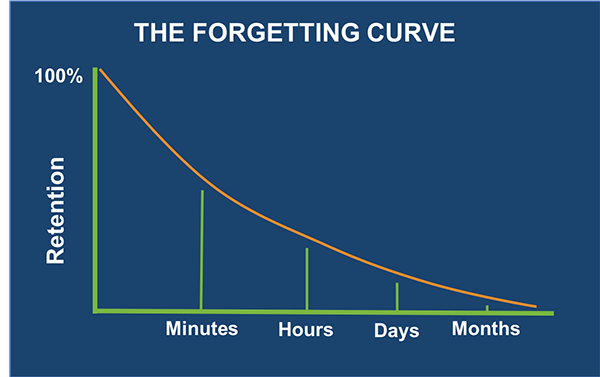Research shows that, on average, students forget 70% of what they are taught within 24 hours of the training experience.The forgetting curve began with German psychologist, Hermann Ebbinghause in the late 19th century. According to Ebbinghaus’ findings and several recent studies, up to 90% of information is lost after one week.

Before you throw your hands up in defeat, know thisYOU can change this fact! If you put the knowledge obtained during training to use right away, memory retention will increase exponentially. Use it or lose it!
Strategies to Combat the Forgetting Curve
What you do after any type of training (on the job, in the classroom, online, etc.) is just as important, if not more important, than what you do during the training. During training you may learn an abundance of great skills and knowledge, but if you don’t use them, you will lose them.
A learning survey revealed that only 12% of learners apply the skills from the training back to their job.
Create an Action Plan, and Do It!
In the hours and days after training:
- Review the information provided during training
- Determine your key takeaways from the training
- Create an action plan to put learning into practice
- Start getting hands on practice using new skills as soon as possible
If you use it, your brain won’t lose it!
Create and Use Job Aids
Create and use training job aids to ensure the concepts are memorized and not forgotten. A job aid is a summary of the main skills or knowledge learned during the training session. Examples of job aids include, checklists, worksheets, quizzes, diagrams, pictures, etc. Anything that will quickly illustrate and reinforce what you have learned.
Take Exams Sooner Rather than Later
According to Ingrid Bradford, Senior Instructional Designer for HDI, “Learners should sit for an exam sooner rather than later. The skills they learn are new and not fully implemented into work habits. They will have more success sitting for an exam shortly after training takes place while the content is fresh.”
Train Others
Share the information you learned with others on your team (as applicable). Give others hands-on training and opportunities to use the skills and knowledge. Continue to reinforce the training you provide. Give positive reinforcement when you see the new skills and knowledge being used by others.
Follow Through
You set the standard on how others should behave. If you put the skills you learn to use right away, others will take notice and follow your lead. If you want to stay competitive in your career, retain information for long-term use, and make positive change in your behavior then use it, don’t lose it!
